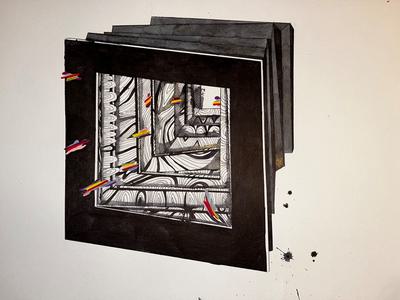I Stole the King's Road
By
Louise Marchal
2010 - 2012
Louise Marchal
The theatre as construction here is printed surface, sculpture, frame/ plinth and integral part of the assemblage. What is shown inside it is the also a place and the vision of a place. A moving digital collage of images of The Kings Road in London. This suggests a fast paced progress down the kings road and images of the street are interpolated with landmark buildings and people in their correct geographical place within the sequence.
Central to the sequence is a battered old studio on Manresa Road where Frances Darlington lived and worked for at least 5 years between 1934 and 1940. This building has become a personal icon for me, because it not only represents Darlington’s last London studio, but on a wider vista, in its decrepit state somehow captures the frailty of the old art scene. A type of art production that relied on studio practise and craftsmanship. The Kings Road has manifold resonances of its own. Steeped in Bohemian history since the days of Rossetti, Chelsea has reverberated velvets, mystics and beats in every ensuing year since Dante Gabriel took a lease out at Cheyne Walk. So much of the British idea of “artist” was associated with that area, with The Pre Raphaelites, Ellen Terry (who lived on the Kings Road), Pink Floyd who recorded at Sound Technique studios on Church Street (where Charles Kingsley who wrote The Water Babies used to live). The Beatles opened up The Apple Store on the Kings Road. Vivienne Westwood and Malcolm McClaren opened up SEX in the 1970s, and Vivienne Westwood’s shop The Worlds End is still there. The Pheasantry has fascinated me ever since I saw photographs by Robert Whitaker at the National Portrait Gallery’s Sixties London exhibition in 1995.
‘I Was Lord Kitchener’s Valet’ somehow seemed to be an integral part of what I was thinking about. This shop originally opened in Carnaby Street in 1966 another branch, ‘I was Lord Kitchener’s Thing’ opened on the Kings Road a couple of years later. According to Peter Blake it was while walking past this shop that gave him and Paul McCartney the idea for the Sergeant Pepper album cover. Reacting to the new modern world being sold in Post War Britain, it sold all sorts of vintage clothes, the type of stuff many people’s grandparents had in their attic. It was simultaneously lauding the old ‘look’, but also wryly laughing at it as being signifier of an old order that was gradually being violently exploded, like all the blitzed parts of London. But it is as though something is salvaged, like an old artwork pulled from the wreck of derelict forgotten studio.
Louise Marchal
Louise Marchal
Louise Marchal
Helping Artists Keep Going
Axis is an artist-led charity supporting contemporary visual artists with resources, connection, and visibility.






